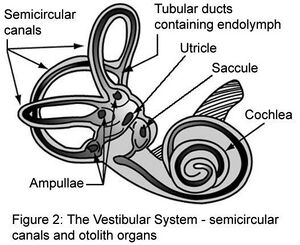Vertigo
Original Editor - Lucinda hampton
Top Contributors - Lucinda hampton, Kim Jackson and Uchechukwu Chukwuemeka
Introduction[edit | edit source]
Vertigo is a symptom, rather than a condition itself.[1] Vertigo is a type of dizziness that is often described as feeling that you are spinning or that the world is spinning around you, particularly if you change position.[2] Vertigo affects all ages. In younger patients, middle ear pathology is most often the cause. In the elderly, specific assessment is needed due to the risk of falls and their complications. The key to arriving at the diagnosis is to differentiate vertigo from other causes of dizziness or imbalance and distinguish central from peripheral causes of vertigo. [3]
Etiology[edit | edit source]
Vertigo is most often caused by a dysfunction in the vestibular system from a peripheral or central lesion.
- Peripheral etiologies include the more common causes of vertigo e.g. benign paroxysmal positional vertigo (BPPV) and Ménière disease. BPPV results from calcium deposits or debris in the posterior semicircular canal and causes frequent transient episodes of vertigo lasting a few minutes or less.
- Central etiologies of vertigo should always be considered in the differential. Ischemic or hemorrhagic strokes (particularly involving the cerebellum or vertebrobasilar system) are causes that could be life-threatening. Other central causes include: Tumors: Vestibular migraines (common central cause of vertigo); multiple sclerosis (associated with both central and peripheral causes of vertigo).
- Other causes can lead to vertigo e.g. medication-induced vertigo and psychologic disorders, including mood, anxiety, and somatization[3].
Epidemiology[edit | edit source]
Vertigo affects both men and women but is about two to three times more common in women than men. It has been associated with various comorbid conditions e.g. depression and cardiovascular disease. Prevalence increases with age and varies depending on the underlying diagnosis. Based on a survey of the general population, the 1-year prevalence of vertigo is about 5% and an annual incidence of 1.4%. [3]
Causes[edit | edit source]
The cause of vertigo is often unknown. [4]
- Vertigo is commonly caused by a problem with the way balance works in the inner ear, although it can also be caused by problems in certain parts of the brain.
- Causes of vertigo include: benign paroxysmal positional vertigo (BPPV); migraines; labyrinthitis; vestibular neuronitis.[2]
- Aircraft pilots and underwater divers are subject to vertigo because the environments in which they work frequently have no reference points by which to orient their direction of movement. The illusions caused by disorientation can have devastating consequences e.g. a pilot may sense that he is gaining altitude when in reality he is losing it, or he may feel that he is steering to the right when he is on a straight course.[4]
Treatment[edit | edit source]
Treatment depends on the cause. In most cases vertigo goes away without treatment. Stress can increase symptoms of dizziness and nausea, and reducing stress can help reduce the symptoms.
If symptoms persist treatment options include:
- Vestibular rehabilitation or balance training: patients may benefit from a type of physical therapy known as vestibular rehabilitation.[4] Vestibular rehabilitation therapy (VRT) is an exercise-based treatment program designed to promote vestibular adaptation and substitution. The goals of VRT are: to enhance gaze stability; to enhance postural stability; to improve vertigo; to improve activities of daily living. VRT facilitates vestibular recovery mechanisms: vestibular adaptation, substitution by the other eye-movement systems, substitution by vision, somatosensory cues, other postural strategies, and habituation.[5]Also, Otago exercise programme could benefit patient suffering from vertigo.
- Medicine: motion sickness medication can be used to relieve some symptoms of vertigo such as nausea, and antibiotics can treat a bacterial infection. Diuretics may be prescribed to reduce the swelling associated with Meniere’s disease.
- Surgery: surgery is only needed in a few cases.[2]
Prognosis[edit | edit source]
Benign paroxysmal positional vertigo recurrence rates are 50% at 5 years. There is the persistence of dizziness related to anxiety in almost a third of patients 1 year after vestibular neuronitis.[3]
References[edit | edit source]
- ↑ NHS Vertigo Available:https://www.nhsinform.scot/illnesses-and-conditions/ears-nose-and-throat/vertigo Available:https://www.nhsinform.scot/illnesses-and-conditions/ears-nose-and-throat/vertigo Accessed 24.8.2021)
- ↑ 2.0 2.1 2.2 Health Direct Vertigo Available:https://www.healthdirect.gov.au/vertigo (accessed 24.8.2021)
- ↑ 3.0 3.1 3.2 3.3 Stanton M, Freeman AM. Vertigo. 2021. Available from:https://www.statpearls.com/articlelibrary/viewarticle/31130/ (accessed 24.8.2021)
- ↑ 4.0 4.1 4.2 Britannica Vertigo Available from:https://www.britannica.com/science/vertigo (accessed 24.8.2021)
- ↑ Han BI, Song HS, Kim JS. Vestibular rehabilitation therapy: review of indications, mechanisms, and key exercises. Journal of Clinical Neurology. 2011 Dec 1;7(4):184-96.









